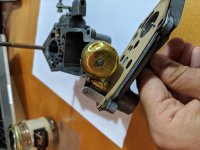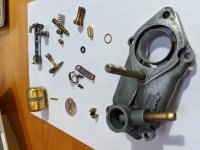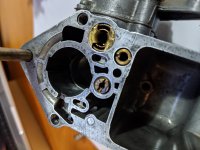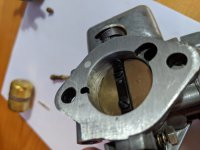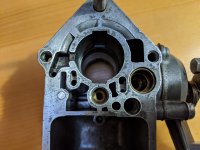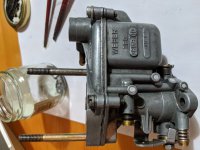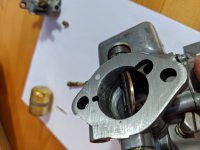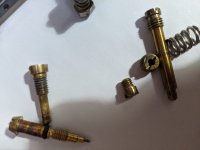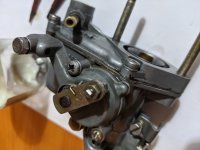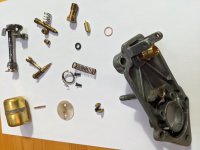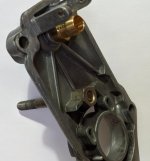the hobbler
Distinguished member
- Joined
- Jul 25, 2012
- Messages
- 4,084
- Points
- 1,013
The easiest way to measure the float level is to use a drill (or a tube or rod) of the correct dimension, which is 7mm when the carb top is held in a VERTICAL position--don't worry too much about the '15mm' dimension. Did you give the float a shake and check that there is no fuel inside it? If there is, that will affect the running ofthe engine--it needs to be replaced (cannot be repaired).
Look on your dynamo-belt pulley--there might be a small 'flat' on the outer side of the casting, which will line up with the timing mark on the oil-filter cover (which will only fit onto the pulley on one position). There will be a corresponding mark (small raised cast 'line') on the timing-chain cover. If you have 'points' ignition you can statically check the timing with a small timing light (bulb with 2 wires and small 'croc-clips' will suffice).The correct static timing for the 500 engine is 10 degress before top dead centre (BTDC), or the mark on the pulley/filter when it is 13mm before the mark on the timing-chain cover (the engine turns clock-wise, looking from the rear of the car). Clip one of the wires from the bulb to the distributor side of the coil and the other wire to the body (earth). Ensure rotor arm is aligned with no '1' on the distributor cap. Remove ignition lead from coil or distributor cap (safety item--so that the car doesn't start on you). Turn engine to set timing marks on pulley/t-c cover, turn ignition on. Turn distributor CLOCKWISE until light is out---then turn distributor ANTI-CLOCKWISE until light just comes on.tighten distributor clamp nut, refit ignition lead.
Look on your dynamo-belt pulley--there might be a small 'flat' on the outer side of the casting, which will line up with the timing mark on the oil-filter cover (which will only fit onto the pulley on one position). There will be a corresponding mark (small raised cast 'line') on the timing-chain cover. If you have 'points' ignition you can statically check the timing with a small timing light (bulb with 2 wires and small 'croc-clips' will suffice).The correct static timing for the 500 engine is 10 degress before top dead centre (BTDC), or the mark on the pulley/filter when it is 13mm before the mark on the timing-chain cover (the engine turns clock-wise, looking from the rear of the car). Clip one of the wires from the bulb to the distributor side of the coil and the other wire to the body (earth). Ensure rotor arm is aligned with no '1' on the distributor cap. Remove ignition lead from coil or distributor cap (safety item--so that the car doesn't start on you). Turn engine to set timing marks on pulley/t-c cover, turn ignition on. Turn distributor CLOCKWISE until light is out---then turn distributor ANTI-CLOCKWISE until light just comes on.tighten distributor clamp nut, refit ignition lead.


